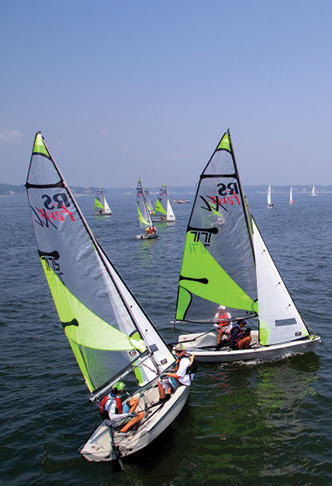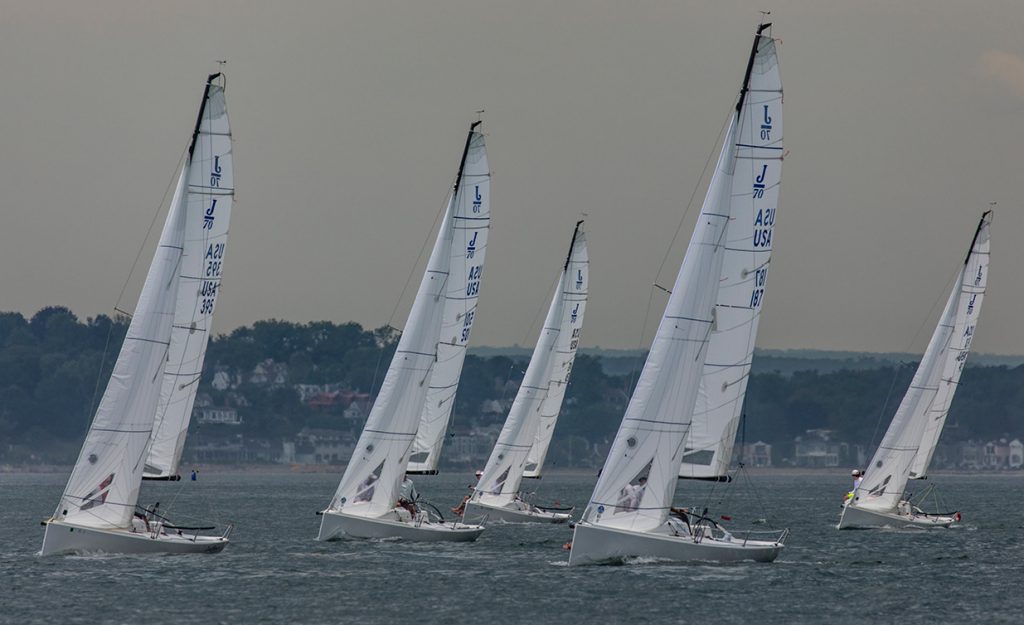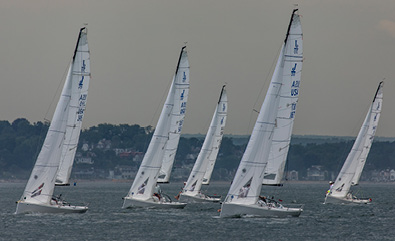When the wind is shifting back and forth (as it often is), the key to a successful first beat is catching the first shift after the start and then staying “in phase” with the breeze until you reach the windward mark. Here are some ideas on how to do that:
• Find the median. With an oscillating breeze, it’s important to figure out the median, or average, wind direction. This is usually the direction that’s midway between the farthest left shift and the farthest right shift you’ve seen. Even more useful than the average wind direction are your median headings on each tack. These are the compass courses you are steering when the wind direction is at its median. You should always know whether you are sailing above or below your median on each tack, since this will tell you if you are lifted or headed.
• Modify your median. Once you figure out your median wind direction and headings, don’t stop thinking about them. Sometimes the average wind direction shifts slightly to the left or right as you sail up the first beat. Make sure you notice this and adjust your numbers accordingly (during the first leg and afterward).
• Tack on the headers. Most racing sailors know that, when the wind is oscillating, they should tack on the headers to sail on the lifts. But when you are getting headed, which is the best time to tack?
If you tack when you first start to get headed, you are probably still on a lift (sailing above your median) so that’s not a good idea. If you wait until you reach your lowest heading, you will have sailed lower than average on that tack when you could have sailed above your median on the other tack. The best time to tack, therefore, is when you are at the median.
• Timing is not so important. In my experience, it’s easier to keep track of the range of shifts than to figure out their timing. So I focus on identifying whether the wind is left or right at any moment, rather than trying to predict when the next shift will come.
There are, however, two times on the first beat when it helps to know about timing. One is at the start when you’re trying to figure out how soon the first shift will come. Another is near the first mark when you need to know whether the wind will shift again before you get there.

On the first beat, you must work hard to take advantage of changes in both wind direction and wind velocity. © Mary Alice Fisher maryalicefisher.com
• The last shift. When you are approaching the windward mark, treat the last oscillation as if it is a persistent shift. That is, instead of tacking on the header as usual, sail farther into it until you fetch the mark.
• Play the middle. It’s usually a good idea to play the middle of the course when the wind is oscillating. This helps you stay away from the laylines, which are dead-ends in a shifty breeze. If you start getting too close to a layline, be willing to tack on smaller headers to head back toward the middle.
• Don’t chase shifts. It can be tempting, when you see a boat nearby on a huge lift, to sail toward that shift and try to get it. However, this rarely works. More often than not, you must sail on a header to reach the other boat. And when you get there, half the time that great shift is gone.
It’s better to focus on sailing in the wind you have. Use other boats as a guide to know how much you are lifted or headed, but don’t try to sail for their shift. One exception to this is that it often works to go out of your way for better wind pressure, especially in lighter air.
• To cover or not? It’s very difficult to “cover” other boats when the wind is shifty. You normally cover by staying between the other boat(s) and the next mark. If you try this in an oscillating breeze, however, you are likely to lose.
That’s because if the boat you are covering is playing the shifts perfectly, you won’t be (since you’re in a different breeze than they are). In shifty winds, you must sail your own race first and worry about other boats second.

© Stephen R. Cloutier
• Sail fast on lifts. If you are sailing on a lift (and you should almost always be sailing on a lift when the wind is oscillating!), you should sail just slightly lower and faster than normal (assuming you will have to tack at least once more on the beat). This will get you to the next shift sooner and maximize your VMG in the direction of the median wind. ■
This article originally appeared in David Dellenbaugh’s Speed & Smarts, The newsletter of how-to tips for racing sailors. If you want to sail faster and smarter, log onto SpeedandSmarts.com.
A resident of Easton, CT, Dellenbaugh was tactician and starting helmsman for America3’s successful defense of the America’s Cup in 1992. He’s a Lightning World Champion, two-time Congressional Cup winner, seven-time Thistle National Champion, two-time winner of the Canada’s Cup, three-time Prince of Wales U.S. Match Racing Champion, and a winner of the U.S. Team Racing Championships for the Hinman Trophy.
- © Stephen R. Cloutier

